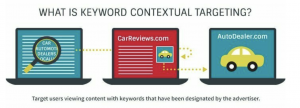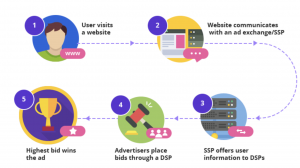How is Contextual Advertising the Future of Programmatic?
The year 2021 experienced a major increase in programmatic ad spending, around $455 billion in 2021. And as the industry continues to grow worldwide, and advertisers expect to achieve better results, this ad spend is expected to grow even further.
And as the industry continues to grow worldwide, and advertisers expect to achieve better results, this ad spend is expected to grow even further.
Thus, in 2022, brands all around the world are expected to spend around $524 billion on the programmatic industry.
Most importantly, with third-party cookies getting blocked, contextual advertising is not a want, but has become the need of the hour and has become the future of programmatic advertising,
What is Contextual Advertising?
Contextual advertising is not a new concept in the advertising industry. But, it was less focused in the previous years with behavioral targeting getting all the attention of advertisers. It allows you to match the content of the webpage to that of the ad. This focuses on providing a unified experience for the user by emphasizing screen content rather than individual individuals.
It displays advertisements on a website based on its  content rather than the user’s data and aligns the website’s content with a certain group of individuals. This targeting takes the category or keywords of the page that the visitor is seeing into account.
content rather than the user’s data and aligns the website’s content with a certain group of individuals. This targeting takes the category or keywords of the page that the visitor is seeing into account.
The Ad Server then shows advertisements that are most relevant to the content of the site. Users respond better to such adverts in this context since the material is tailored to their present requirements.
With Google, Apple, and many other large businesses taking drastic steps to block third-party cookies as users’ privacy concerns grow, contextual advertising has once again taken center stage.
How does Contextual Targeting Work?
Contextual advertising used contextual information to deliver ads based on the content shown. It is concerned with what content is seen rather than who views it.
Marketers may provide a message that is more relevant and likely to inspire action by understanding the content on the page as well as the environment or site it appears on.
The main difference between contextual targeting and other ad-targeting solutions is that contextual tools use page-level data instead of audience data based on third-party cookies.
Understanding Programmatic Advertising and its Importance
Programmatic advertising is a fully automated data-driven approach to purchasing and selling advertising space on the website of publishers. 
Here, brands can offer the correct ad to the right customer in real-time using complicated algorithms and machine learning.
Programmatic advertising has helped change the way businesses purchase and sell ad space. It was designed to replace the old, manual process of RFPs, discussions, contracts, time, and financial resources. It also enabled real-time ROI measurement of ad campaigns.
Why is Contextual Advertising the Future of Programmatic Advertising?
Contextual targeting is one of the easiest means to start with programmatic advertising by using terms that explain your product or service.
It plays an important role in engaging new consumers on a large scale which is effective for display advertising campaigns, including video and native ads.
The main advantage of this form of advertising is that brands can continuously access the same audience throughout the web and also be in front of the relevant audience at the correct time.
Programmatic advertising is a well-known performance marketing channel where the advertiser leverages the audience segmentation data to help brands deliver ads strategically to their consumers using contextual targeting.
When contextual ad targeting combines with programmatic advertising it lets the advertisers increase their ad budget by bidding on high-value impressions, boosting their click-through rate, and experiencing a rise in their ROI.
However, the main reason why contextual advertising has taken center stage in the world of programmatic advertising is the depreciation of third-party cookies.
Ban on Third-Party Cookies
With the GDPR and CCPA regulations, the privacy of users’ data has been given a lot of importance. With the demise of 3rd party cookies, their removal from Firefox and Safari; and also from Google by mid 2023 advertisers need to find a way to get close to users. This requires ads to be more “personalized”.
2023 advertisers need to find a way to get close to users. This requires ads to be more “personalized”.
Because no user data is gathered, contextual advertising is an obvious choice for the Ad Market. Such information is also not required to offer the appropriate sort of adverts on the web. Thus, contextual targeting can be considered the future of programmatic advertising.

 317-289-4965
317-289-4965